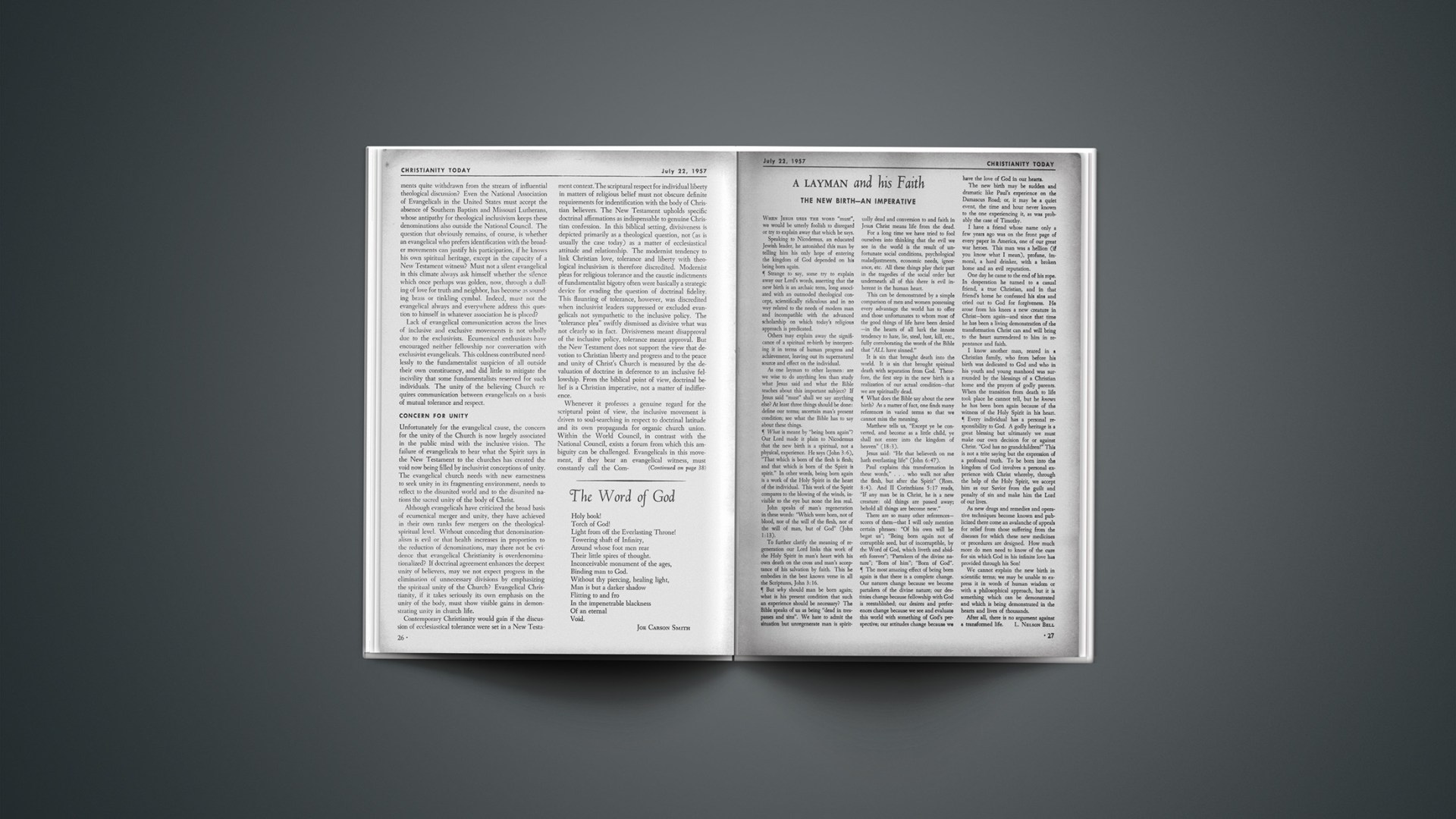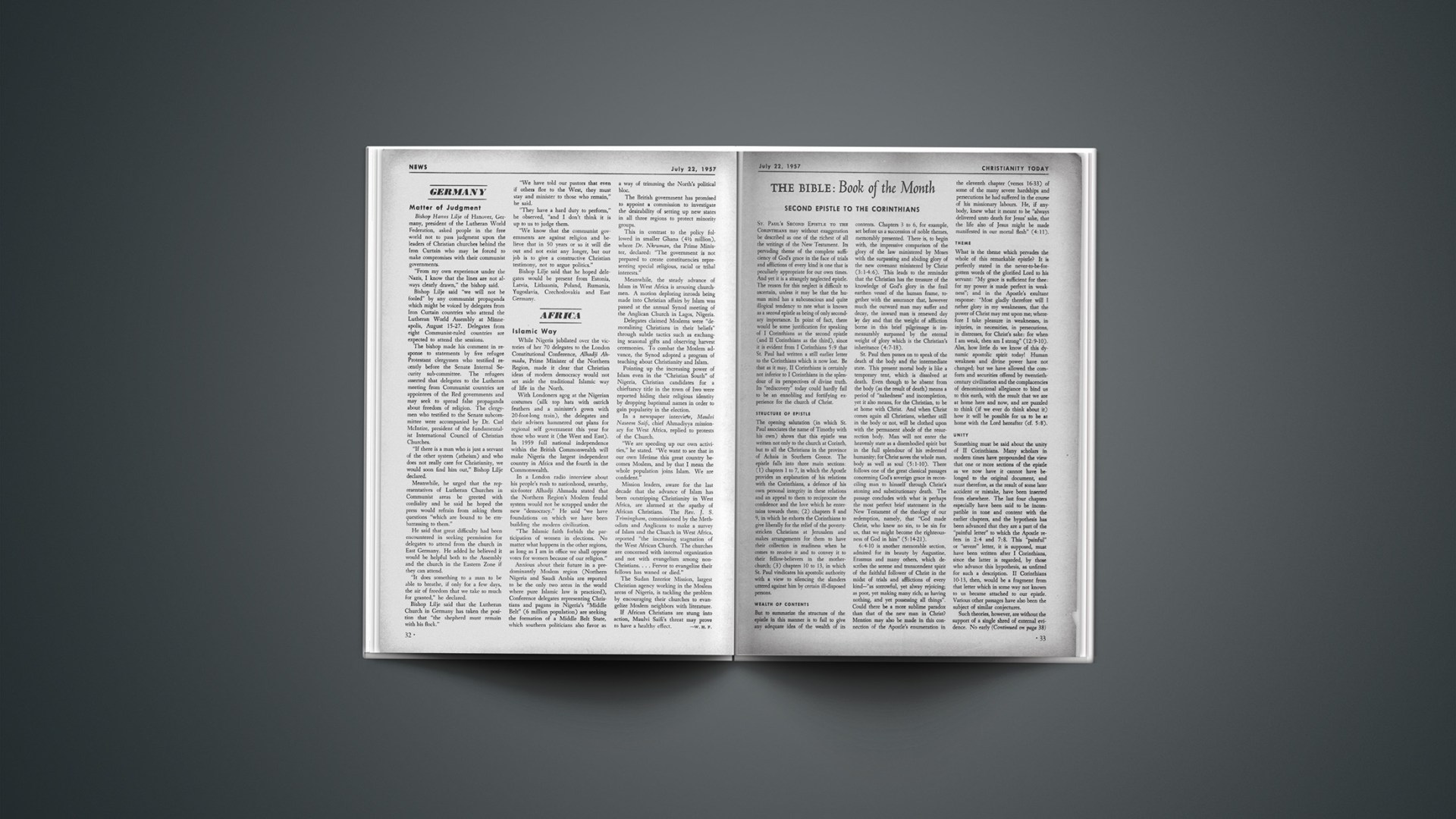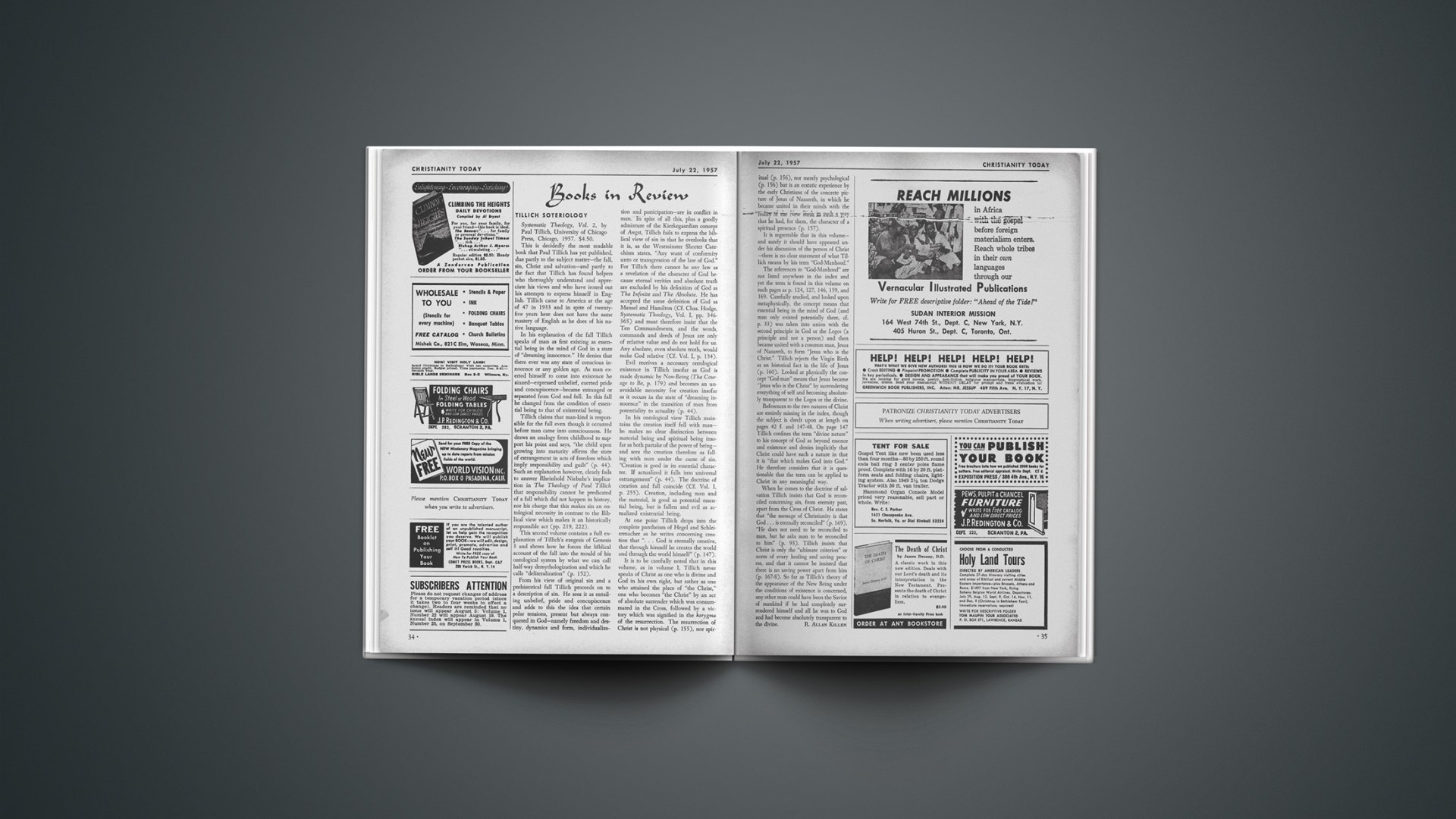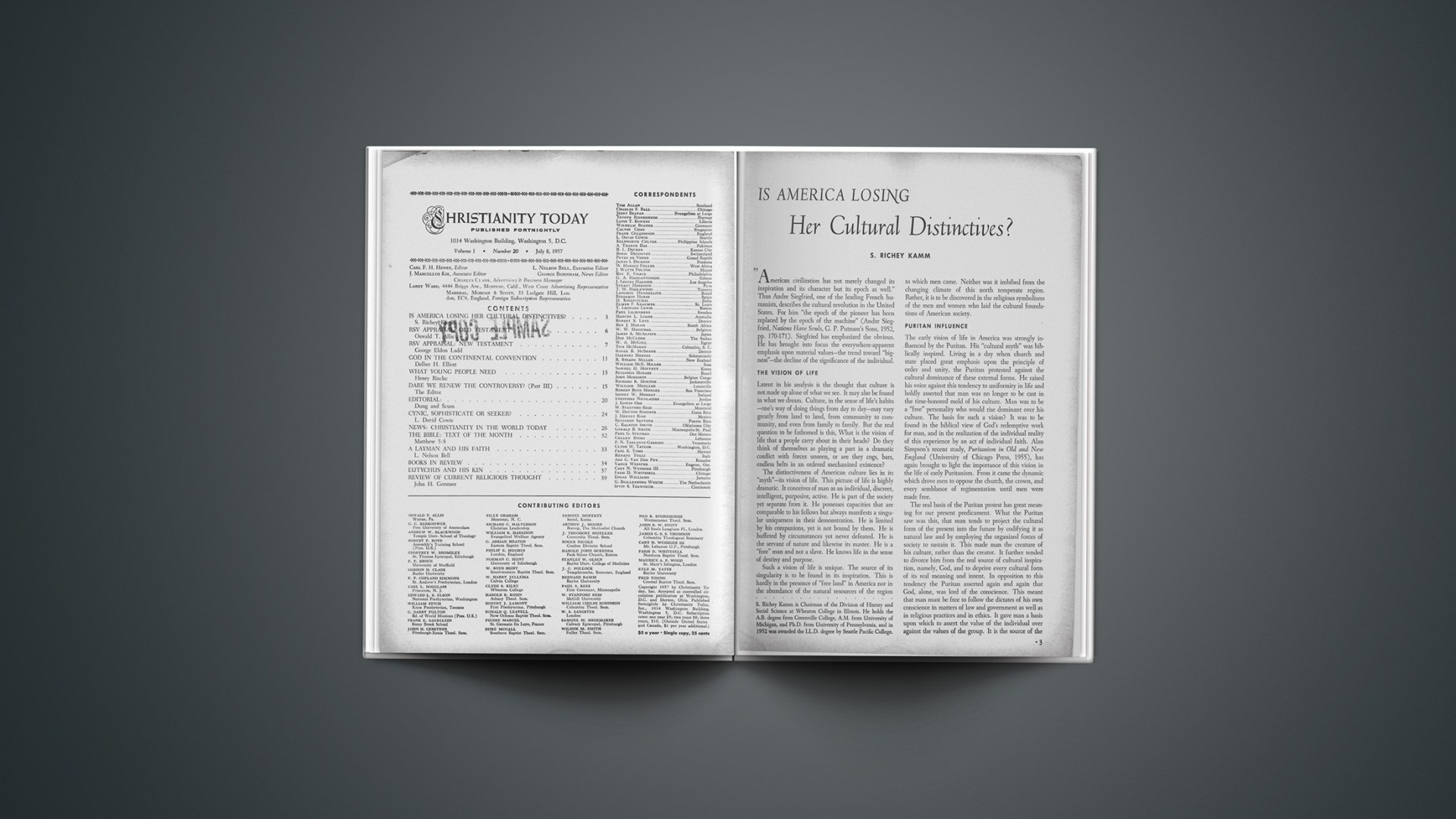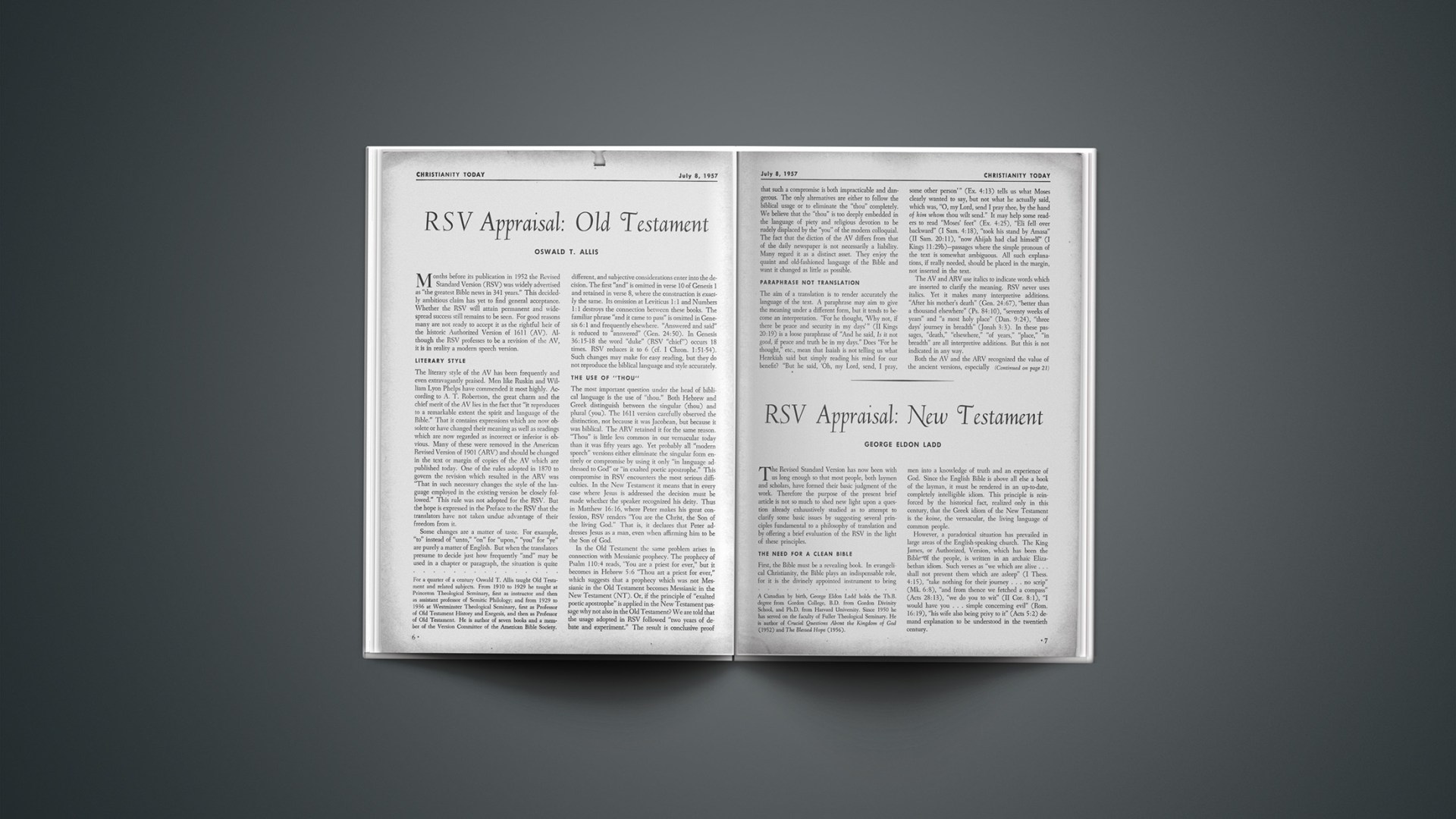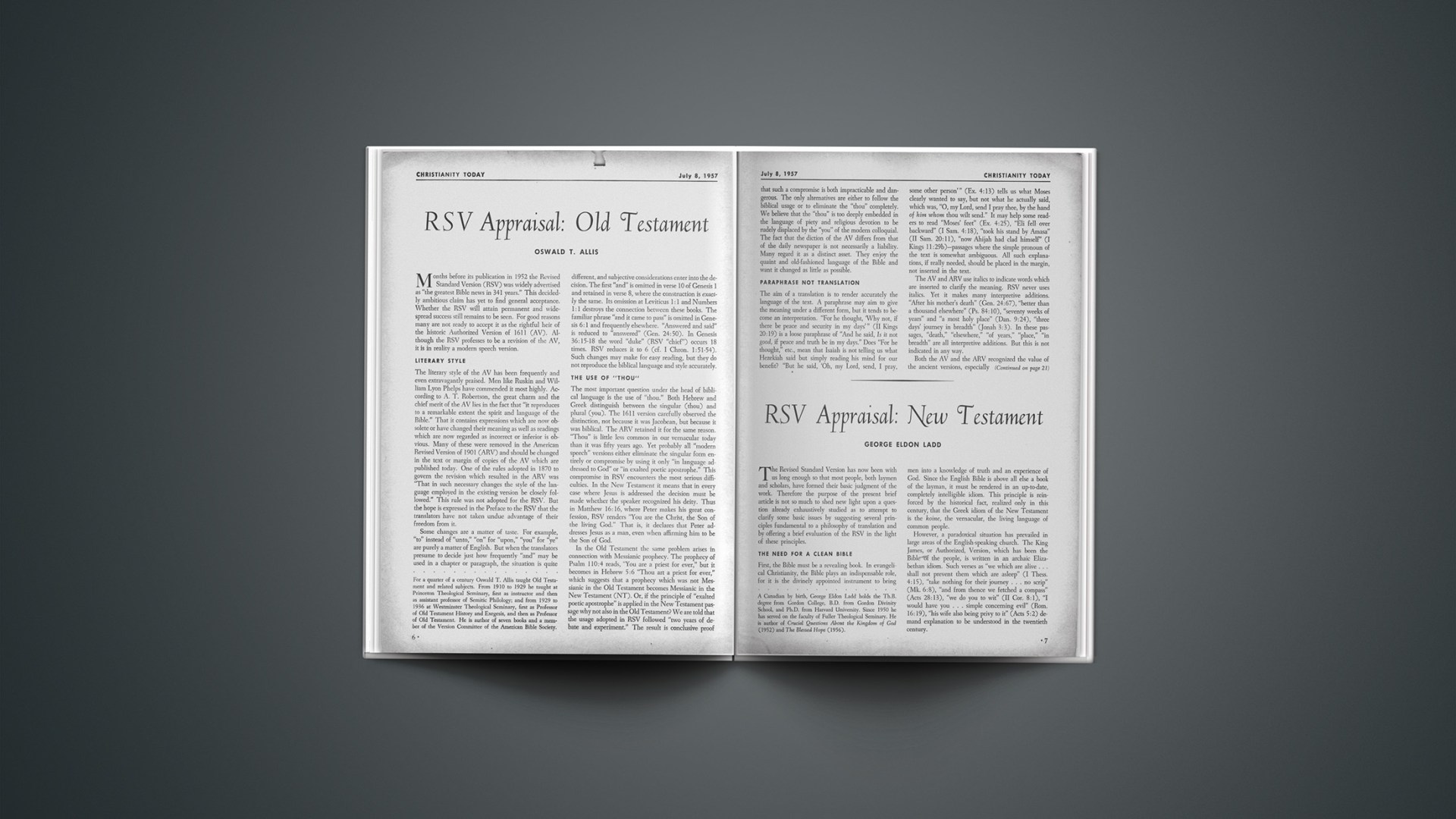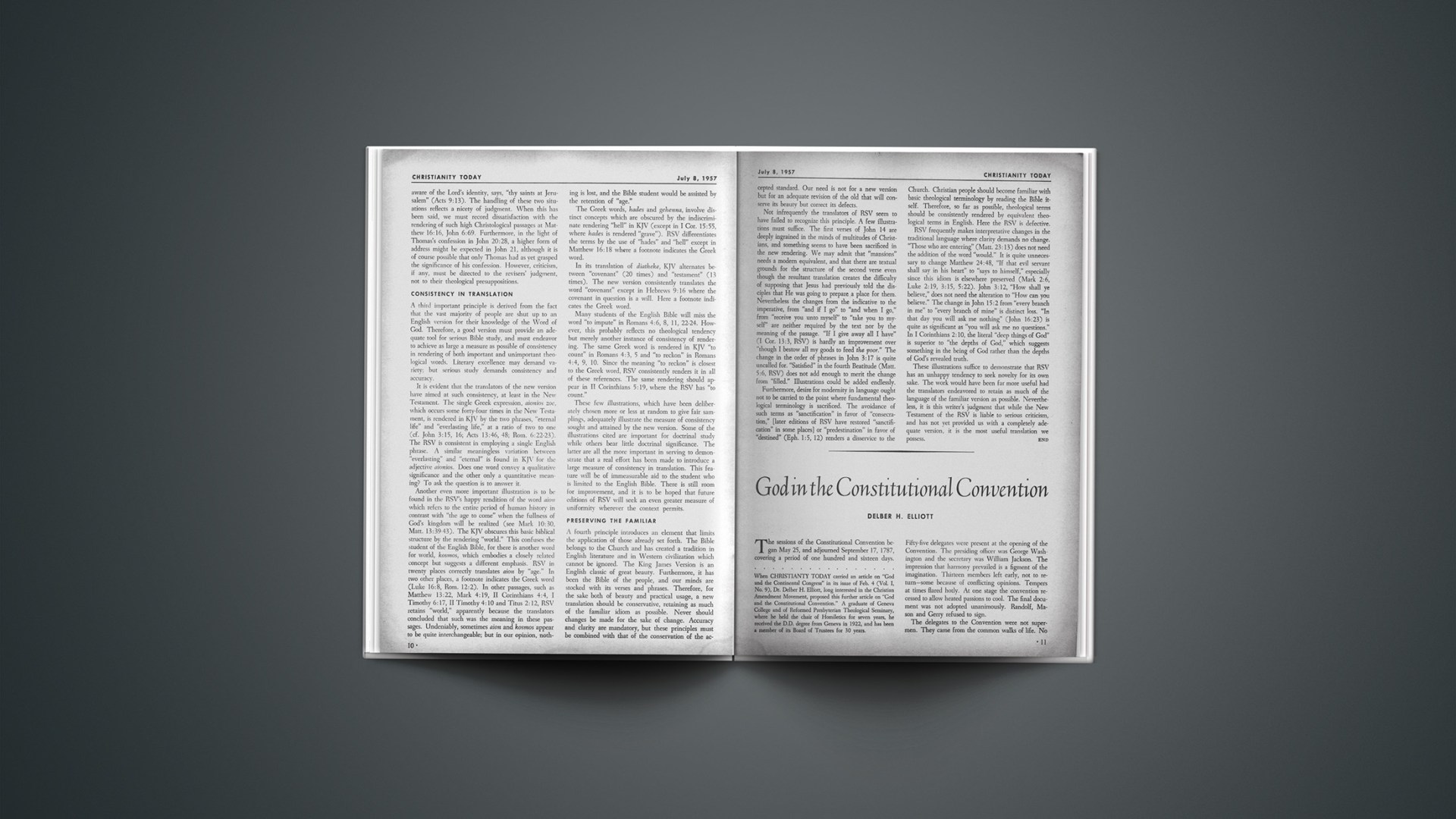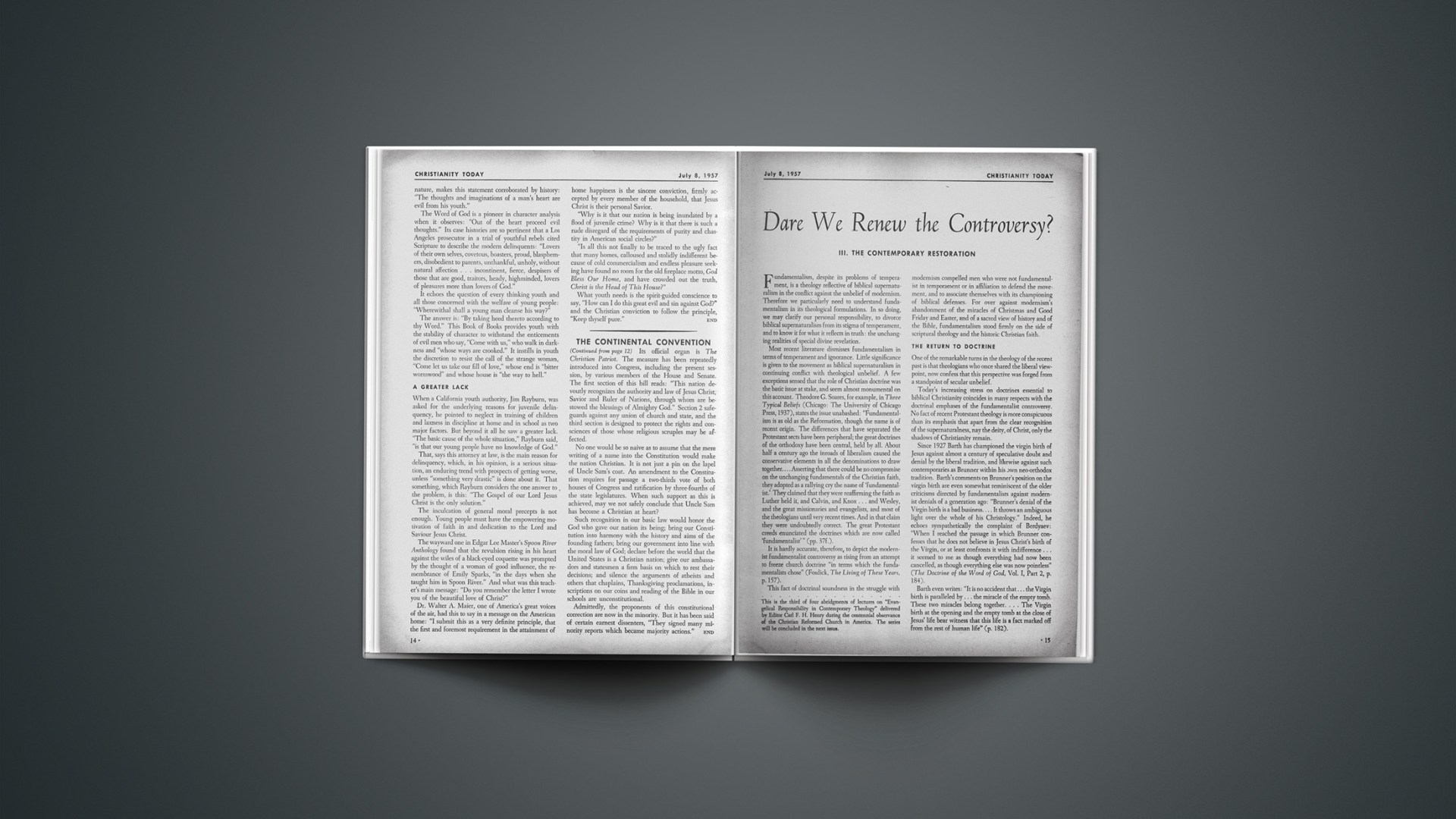When Jesus uses the word “must”, we would be utterly foolish to disregard or try to explain away that which he says.
Speaking to Nicodemus, an educated Jewish leader, he astonished this man by telling him his only hope of entering the kingdom of God depended on his being born again.
Strange to say, some try to explain away our Lord’s words, asserting that the new birth is an archaic term, long associated with an outmoded theological concept, scientifically ridiculous and in no way related to the needs of modern man and incompatible with the advanced scholarship on which today’s religious approach is predicated.
Others may explain away the significance of a spiritual re-birth by interpreting it in terms of human progress and achievement, leaving out its supernatural source and effect on the individual.
As one layman to other laymen: are we wise to do anything less than study what Jesus said and what the Bible teaches about this important subject? If Jesus said “must” shall we say anything else? At least three things should be done: define our terms; ascertain man’s present condition; see what the Bible has to say about these things.
What is meant by “being born again”? Our Lord made it plain to Nicodemus that the new birth is a spiritual, not a physical, experience. He says (John 3:6), “That which is born of the flesh is flesh; and that which is born of the Spirit is spirit.” In other words, being born again is a work of the Holy Spirit in the heart of the individual. This work of the Spirit compares to the blowing of the winds, invisible to the eye but none the less real.
John speaks of man’s regeneration in these words: “Which were born, not of blood, nor of the will of the flesh, nor of the will of man, but of God” (John 1:13).
To further clarify the meaning of regeneration our Lord links this work of the Holy Spirit in man’s heart with his own death on the cross and man’s acceptance of his salvation by faith. This he embodies in the best known verse in all the Scriptures, John 3:16.
But why should man be born again; what is his present condition that such an experience should be necessary? The Bible speaks of us as being “dead in trespasses and sins”. We hate to admit the situation but unregenerate man is spiritually dead and conversion to and faith in Jesus Christ means life from the dead.
For a long time we have tried to fool ourselves into thinking that the evil we see in the world is the result of unfortunate social conditions, psychological maladjustments, economic needs, ignorance, etc. All these things play their part in the tragedies of the social order but underneath all of this there is evil inherent in the human heart.
This can be demonstrated by a simple comparison of men and women possessing every advantage the world has to offer and those unfortunates to whom most of the good things of life have been denied—in the hearts of all lurk the innate tendency to hate, lie, steal, lust, kill, etc., fully corroborating the words of the Bible that “ALL have sinned.”
It is sin that brought death into the world. It is sin that brought spiritual death with separation from God. Therefore, the first step in the new birth is a realization of our actual condition—that we are spiritually dead.
What does the Bible say about the new birth? As a matter of fact, one finds many references in varied terms so that we cannot miss the meaning.
Matthew tells us, “Except ye be converted, and become as a little child, ye shall not enter into the kingdom of heaven” (18:3).
Jesus said: “He that believeth on me hath everlasting life” (John 6:47).
Paul explains this transformation in these words,” … who walk not after the flesh, but after the Spirit” (Rom. 8:4). And 2 Corinthians 5:17 reads, “If any man be in Christ, he is a new creature: old things are passed away; behold all things are become new.”
There are so many other references—scores of them—that I will only mention certain phrases: “Of his own will he begat us”; “Being born again not of corruptible seed, but of incorruptible, by the Word of God, which liveth and abideth forever”; “Partakers of the divine nature”; “Born of him”; “Born of God”.
The most amazing effect of being born again is that there is a complete change. Our natures change because we become partakers of the divine nature; our destinies change because fellowship with God is reestablished; our desires and preferences change because we see and evaluate this world with something of God’s perspective; our attitudes change because we have the love of God in our hearts.
The new birth may be sudden and dramatic like Paul’s experience on the Damascus Road; or, it may be a quiet event, the time and hour never known to the one experiencing it, as was probably the case of Timothy.
I have a friend whose name only a few years ago was on the front page of every paper in America, one of our great war heroes. This man was a hellion (if you know what I mean), profane, immoral, a hard drinker, with a broken home and an evil reputation.
One day he came to the end of his rope. In desperation he turned to a casual friend, a true Christian, and in that friend’s home he confessed his sins and cried out to God for forgiveness. He arose from his knees a new creature in Christ—born again—and since that time he has been a living demonstration of the transformation Christ can and will bring to the heart surrendered to him in repentance and faith.
I know another man, reared in a Christian family, who from before his birth was dedicated to God and who in his youth and young manhood was surrounded by the blessings of a Christian home and the prayers of godly parents. When the transition from death to life took place he cannot tell, but he knows he has been born again because of the witness of the Holy Spirit in his heart.
Every individual has a personal responsibility to God. A godly heritage is a great blessing but ultimately we must make our own decision for or against Christ. “God has no grandchildren!” This is not a trite saying but the expression of a profound truth. To be born into the kingdom of God involves a personal experience with Christ whereby, through the help of the Holy Spirit, we accept him as our Savior from the guilt and penalty of sin and make him the Lord of our lives.
As new drags and remedies and operative techniques become known and publicized there come an avalanche of appeals for relief from those suffering from the diseases for which these new medicines or procedures are designed. How much more do men need to know of the cure for sin which God in his infinite love has provided through his Son!
We cannot explain the new birth in scientific terms; we may be unable to express it in words of human wisdom or with a philosophical approach, but it is something which can be demonstrated and which is being demonstrated in the hearts and lives of thousands.
After all, there is no argument against a transformed life.
WORLD NEWS
Christianity in the World Today
One of the largest crowds in Billy Graham’s New York Crusade turned out the night he delivered a special address to the thousands who had made decisions there to live for Christ.
An estimated 19,000 jammed Madison Square Garden for the sermon on “How to Live A Christian Life.”
Mr. Graham began by asking, “Who is a Christian?” Before answering, he described some people who are not Christians. He said:
“A person is not a Christian because his parents were Godly people. Christian parents are wonderful, but they can’t make the decision for a child. He must do it himself. A person is not a Christian just because he is sincere. My mother thought she was giving me cough medicine once, but she had poured out some poison. She was sincere, but she was sincerely wrong.
“A person isn’t a Christian just because he follows his conscience. His conscience may be dead. You aren’t a Christian because of your feelings. Feelings change.
“Then who is a Christian? I’ll tell you. A Christian is a-person in whom Christ dwells. The Scripture says, ‘Christ in you, the hope of glory.’
“A Christian is a person who believes that his sins have been forgiven through the shed blood of Jesus Christ. The devil will try to make you doubt this. How can you know your sins have been forgiven? Because God said so, and God can’t lie.
“A period of adjustment follows the decision to live for Christ. Your life has been changed. Christian growth must begin unless you are to remain a spiritual baby. Some people never grow spiritually and many of our churches are filled with babies. These people are among the most miserable on earth, because they don’t feel at home with Christ and they don’t feel at home with the world. They want both, and it doesn’t work.
“How does a Christian grow? I am going to list five ways. There are others, but these are five of the most important.
“First, a Christian grows when he prays. When you were a baby, you had to learn to walk. You learn to pray the same way. God doesn’t expect your words to be perfect. When I heard my son, Franklin, say ‘da-da’ for the first time, the words were more beautiful than any ever used by Churchill. I am going to be a little worried, however, if he is still saying ‘da-da’ when he is 12 years old.
“It’s a shame that our churches are practically empty for Wednesday night prayer meetings. The person who waits to pray until he feels like it, will never pray. The devil will see to that. The Bible says you are to pray without ceasing. This means that you can be in a spirit of prayer while driving the car, walking down the street, working in the office or wherever you may be.
“Every Christian should have a quiet time alone with God every day. Your spiritual life will never be much without it.
“Prayers should be filled with praise to God, with thanksgiving for all the wonderful things he has done. Self-examination should be in your prayers, as you confess shortcomings. God is interested in hearing your personal requests, no matter how small. You should seek guidance in prayer. An important thing to remember is that you should pray that God’s will be done and not your will. People make mistakes. God doesn’t.
“Second, a Christian grows when he reads the Bible. This should happen every day, without fail. The Word of God cleanses the heart. Many people don’t read the Bible because they don’t understand it all. I want to tell these people that they will never understand all the Bible. I passed a big milestone in my own Christian life one day when I knelt before God and confessed there were many things in the Bible I didn’t understand, but that I was going to accept it all as the inspired Word of God, by faith. From that moment, the Word became a living fire in my soul.
“Turn off the television set and read the Bible. Begin in the New Testament if you’re a new Christian. It’s easier to understand. Don’t read to see how many chapters you can cover. It’s better to read two or three verses and meditate upon them.
“Make sure you have a Bible with big print. One of the devil’s biggest tricks is to have Bibles with small print, so people won’t read them. In addition to the King James Version, I would recommend the Phillips Translation.
“Third, a Christian grows when he leads a disciplined life. Your bodies, minds and tongues should be disciplined. Practice self-control. The Holy Spirit will give you the strength to become Christian soldiers.
“Many temptations will come to do battle with such discipline, but in Christ you can resist. The Bible says, ‘There hath no temptation taken you but such as is common to man, but God is faithful, who will not suffer you to be tempted above that ye are able; but will with the temptation also make a way to escape, that ye may be able to bear it.’
“The tempter will flee when you answer with a verse of scripture. It’s impossible to argue or rationalize with the devil. Jesus, the Son of God, answered temptation by saying, ‘It is written.…’
“A little boy expressed it very well one day when he said, ‘Everytime temptation knocks, I just send Jesus to the door.’
“Fourth, a Christian grows by being faithful in his church. Going to church is not optional; it’s necessary. God says we are not to forsake the assembling of ourselves together.
“Lots of people today don’t go to church because it is too hot. In the winter they don’t go because it is too cold. I’m afraid I don’t know the ideal church temperature.
“Many figure that the preacher is doing a fine job if he doesn’t go five minutes beyond 12. But if that happens, they are ready to get another one. It may surprise some of you to know that you don’t go to church just to hear a preacher. You go to worship God.
“Get into a good church where the Bible is preached and Christ is exalted. Get to work for God. Join a Bible studycell in your church. The communists borrowed this method from the early church and their godless doctrine spread like wildlfire.
“Five, a Christian grows through service. Be a soul winner. There’s a difference between a witness and a soul winner. A soul winner is filled with the Spirit of God. He visits the sick. He gives to the poor. He loves his enemies. He is kind to his neighbors. Anyone can walk up to another on the street and bark, ‘Brother, are you saved?’ It takes more than that.
“We have a lot of witnesses today but very few soul winners.”
Wall Street Rally
12,000 persons, from financiers to clerks, jammed Wall and Nassau Streets for four blocks in all directions to hear Billy Graham speak on sin, business and money from the steps of the Federal Hall Memorial.
The evangelist told the crowd that “you can make millions of dollars and not find God, if you are separated by sin from Him who is the source of all peace and happiness.”
Immigration Bill
The National Association of Evangelicals has voiced objections to Senate Bill 2410, introduced by Senator John F. Kennedy (D.-Mass.)—providing for an annual redistribution of unused quotas.
Such a provision means that quotas from such countries as England, Ireland and Germany, which are seldom filled, could be assigned to regional pools. This would give emigrants from Europe, Asia, Africa and Oceania a second chance of coming to the U. S.
Dr. Clyde W. Taylor, NAE Secretary of Public Affairs, said the bill “provides for a shift of quotas from the unused ones for western and northern Europe, that have provided our main cultural emphasis, to southern and eastern Europe, that are Roman Catholic and decidedly of minority cultural emphasis. Moreover, its philosophy is that we have a moral obligation to help handle population surpluses.”
The bill was praised by Msgr. Edward E. Swanstrom, executive director of Catholic Relief Services. He said “it is particularly gratifying to know that Senator Kennedy and his colleagues have drafted a bill which the senator says ‘is a strong bill and one which no member of the Senate need feel any hesitancy in supporting.’ ”
The Walter-McCarran Act, passed in 1952, provides that the annual quota for any one of the 85 major quota areas shall equal one-sixth of one per cent of the number of inhabitants of the United States, based on the 1920 census. The House Un-American Activities Committee claimed recently, said the NAE, that the Communist Party has created over 180 organizations for the purpose of bringing “grass roots” pressure on Congress to destroy the Walter-McCarran Act.
Worth Quoting
“Of all the panaceas ever set forth in the world to remedy the ills of the human race, there is only one that is effective. That is the gospel of God’s saving grace. This is no over-simplification of a complex problem. It is the one and only basis upon which the superstructure of any temple of peace can be erected. If there is one question upon which we can pronounce dogmatically it is this, that until man has first made peace with God he will never be at peace for any length of time with his fellow-men.”—
JAMES H. HUNTER, author.
People: Words And Events
Editor Dies—Dr James Richard Joy, 93, editor of The Christian Advocate from 1915 to 1936, died July 1 at Manhattan General Hospital. Since 1936 he had been librarian of the Methodist Historical Society. From 1891 to 1904 he was on the editorial staff of the Methodist Book Concern.
Medal of Honor—The Pentagon indicates it will switch its “non-combat” stand and approve a Senate resolution to award the Congressional Medal of Honor posthumously to four chaplains who lost their lives in the sinking of the troopship Dorchester during World War II. The chaplains perished on Feb. 3, 1943, after giving their life preservers to servicemen on the transport. They were The Rex. George L. Fox, Gilman, Vt. (Methodist); The Rev. Clark V. Poling, Schnectady, N. Y. (Reformed Church in America); The Rev. John P. Washington, Newark, N. J. (Roman Catholic) and Rabbi Alexander D. Goode, York, Pa.
Poll on Parsonages—Most clergymen are not in favor of having parsonages right next to churches, according to a survey made by the Southern California-Arizona Methodist Conference. “There is a tendency to encroach upon the privacy of the home life of the parsonage family” when it is next door, said a majority. They expressed a preference for at least three bedrooms with rugs, draperies or curtains supplied. At least one bedroom should have twin beds and all should have “good” mattresses. One full-length mirror is “helpful.” Of the 217 clergymen polled, 174 voted for two or more bathrooms.
Teen-Agers Pray—About 3,000 teenagers, delegates to the 13th annual convention of Youth for Christ International, spent a night in prayer at Winona Lake, Indiana, for Billy Graham’s New York Crusade.… Madison Square Garden officials said Graham has outlasted and outdrawn all previous attractions in the arena’s 30-year history. In seven weeks the Crusade attracted 824,300. The previous record was made in 1947 by the Ringling Brothers, Barnum and Bailey Circus, which ran for 40 days with a total audience of 785,813.
Children’s Center—Dr. Daniel Poling, editor of “The Christian Herald,” has donated his house and 400 acres of property at Deering, N. H., for use as a children’s center.
Good News—Churchmen received good news when the U. S. Supreme Court ruled that “obscenity is not within the area of constitutionally protected speech or press.” The high court upheld four laws—an 1872 Federal law making it criminal to send obscene matter through the mails, a California law against writing, publishing, selling or exhibiting obscene matter and a Newark ordinance banning “strip tease” acts in theaters.
Chaplain of Year—Secretary of the Army Wilbur M. Brucker presented the Army Chaplain of the Year award to Chaplain (Major) Arthur E. Mills (Advent Christian) of Aurora, Ill. Chaplain Mills, who has twice won the Silver Star for gallantry in action, is now post chaplain at Fort Monroe, Va.
Business Men Go—Evangelist Tommy Hicks challenged the delegates to the fifth annual convention of the Full Gospel Business Men’s Fellowship International: “In the mission fields, the doors are closing to preachers and missionaries, but they are open to businessmen. Businessmen are doing something they have never done before—leaving their businesses for short periods and going out to the ends of the earth to witness to the untold dying millions, and paying their own expenses to do it.” 175 responded at two meetings when Hicks challenged them to go.
Conservative Debate—The possible addition of the word “premillennial” to the doctrinal statement caused considerable debate at the June annual Fellowship of Conservative Baptists. No vote was taken.
Digest—Church construction set a new record for the month of June, amounting to $73,000,000.… Evon Hedley, Toronto, appointed executive director of Youth for Christ International to succeed Dr. Ted W. Engstrom, new president of YFC.… G. Keith Hargett named director of film distribution for Moody Bible Institute. He gave famous “Sermons from Science” demonstrations for six years.
3 Hours In Queue
Alejandro Clifford, a journalist from Cordoba, Argentina, made a special trip to New York City recently and attended one of the Billy Graham Crusade meetings. He stood in a line outside Madison Square Garden for three hours. These are the things he heard and felt:
It was pouring rain. I did not know what to do or where to go on Sunday in New York. The great city seemed a far from cheerful place at 3 p.m. to this South American journalist with his one suit of clothes and one pair of shoes.
I decided to make for Madison Square Garden, which was quite close to my hotel, and to stand in the line for the Billy Graham meeting, if there should be a line at such an early hour. To my surprise, people were queueing up, and more and more kept arriving.
Though I had a press card which entitled me to a good seat, I decided to stay in the line. I wanted to know what sort of people were being reached by the New York campaign. Were they, as some said, people who do not need reaching? I was soon able to answer that question and several others. The line of folk waiting at 3:30 for the opening of the doors of the Garden at 6, was a crosssection of the world. I saw people of all ages, races, social conditions. Vigorous youth, the crippled, the blind. And suddenly my own little section of the queue became very interesting as people got friendly and began to talk.
I was wedged in tightly between two middle-aged colored women. The one on my left leaned over me and addressing the one on my right asked: “What church do you belong to, lady?” After a short pause there was a shamefaced reply: “No church.” A shocked “That’s not good!” from my left, was followed by an explanation from my right: “When I was a little girl I went to Sunday School and church, but I have been nowhere for many years. I’m coming every night to hear Billy, because I know his message is the truth, and I want to find Christ.”
The well dressed lady in front of me turned and said: “I am Swedish. When I was a girl, I used to go to the Lutheran Church, but in the States I have never been anywhere. Now I have become a Christian, thanks to Billy Graham.”
Four policemen were sheltered from the rain just a couple of yards from where I was standing. They were discussing baseball but soon switched over to a discussion of Billy Graham. Some of the remarks were far from complimentary. One of the policemen, a young, earnest looking fellow, asked his mates if they had taken the trouble to listen to Billy, then added: “I never bothered to listen to the guy until last night. I can tell you I never heard anything like it in my life. You’d better listen before you talk.” And with that they separated.
A stoutish overdressed woman in her early thirties, who was standing just behind me asked: “Can anyone tell me where I can find the story of the little man who climbed a tree because he wanted to see Jesus?” At once several Bibles were pulled out, and the man who was standing beside her showed her the passage in Luke. Zacchaeus was merely an excuse to start a conversation, for the woman continued: “I do wish I could understand this question of being born again. I listened to Billy’s sermon on John 3:16 last night. I went home and memorized the verse, but I can’t understand how one can obtain eternal life or be born again.”
The man with the Bible got busy and gave her a very clear explanation of the way of salvation. Then suddenly the woman said: “I am Jewish. Do you think the Lord Jesus Christ would receive a Jewess?” The man read several passages, Isaiah 53 among them. A German woman who was standing quite close to the Jewess, patted her on the back and handed her a couple of tracts written specially for Jews. As she did so she said: “Take these, Madam. I am a German, and I feel that by doing humble work and serving the Jews, I can atone in a small way for the terrible manner in which my nation treated them. And then, it gives me a chance to talk to them about my Saviour, their Messiah.”
And so it went on. The people were so interesting! The young colored schoolmaster, now employed by United Nations, who had just lost his teaching job because he insisted on reading the Bible to his students; the young man with the long hair who wanted to argue about the age of the earth, but did not wish to discuss sin; the smiling Oriental who did not seem to understand much English but who certainly showed that he was on the Lord’s side.
When the doors opened, I went in. Billy spoke very simply, but with power, on the Second Coming of Christ. And when the invitation was given, I felt the tears running down my cheeks as I saw that my Jewish friend of the queue was one of the first to go forward.
People can tell me whatever they like now about the sort of folk Billy Graham reaches or doesn’t reach. It won’t worry me. I know the truth. I stood for nearly three hours in the queue.
Brother Team
The Rev. B. O. Baker, pastor in Fort Worth for the last 10 years, and his brother, Dick, who worked with Howard Butt as associates in Billy Graham’s New York Crusade, have formed a new evangelistic team.
All campaigns will be conducted through church sponsorship.
Both are graduates of Baylor University and Southwestern Baptist Theological Seminary.
During the 10 years the Rev. B. O. Baker was pastor of Birchman Avenue Baptist Church in Fort Worth, the annual budget increased from $28,000 to $110,000, property value from some $50,000 to $350,000 and membership from 500 to 1,800. He will do the speaking for the team.
Dick Baker will be the music director. He was founder and director during college days of the Baylor Religious Hour Choir. Some of the songs he has written include Longing for Jesus, Keep Looking Up and Lord, Send Revival.
Brewer Suggestions
Brewers are reportedly weeping into their beer because their product failed to show an increase in sales last year. American Brewer has rushed forward with some suggestions to change the trend:
“Make the serving of beer predominate at all industry events. We are producers and salesmen of beer. We must also be consumers.
“Each employee is a potential salesman, and all must be encouraged to not only drink beer but promote its usage among families and friends. Could not brewery unions, which have a big stake in our industry, cooperate in this direction?”
School Decision
The following special article was written forCHRISTIANITY TODAYby Peter de Visser, publisher of Grand Rapids (Mich.) International Publications.
The Christian Reformed Church, at the June Centennial Synod in Grand Rapids, Michigan, started off its second century with a strong reaffirmation of support to Christian education. The Synod voted, 88 to 22, to continue its ownership and operation of Calvin College and Seminary, rather than to turn the denominational schools over to private society operation. The Synod backed up its decision by approving relocation of the schools to a new and expanded campus, authorizing the construction of five buildings—one for the seminary, two dormitories, a power and heating plant and a physical education building to cost a total of $3,500,000 and to constitute the first units of the new 166-acre campus at Knollcrest, southeast of Grand Rapids.
A minority report of the Board of Trustees’ long-range planning committee had suggested that the college ought eventually to be turned over to a private educational society. The decisions to retain control, to remain in Grand Rapids and to expand on a new and larger campus, settled for the time being the efforts of some to have the college and seminary moved to Chicago, New York or Los Angeles and of others to curtail the the college to the upper two years and establish regional junior colleges in various sections of the U. S. and Canada. Part of the funds for the new three-quarter-million-dollar seminary building are already on hand, as funds for this project as a Centennial Memorial were raised at a special Centennial Thank-offering April 7, which brought in about $300,000. The college and seminary combined now have nearly 2,000 students.
A move toward eventual organization of regional synods, to meet on alternate years, was taken with appointment of a committee to draw up a specific plan of reorganization, to be presented to a future synod. At present the general synod meets each year.
Backing for increased missionary activity, both at home and abroad, was embodied in several actions. The Board of Foreign Missions was authorized to lend personnel assistance to the Reformed Church of Korea. Similar assistance was offered to the Reformed Churches of Australia and New Zealand, composed chiefly of recent Dutch immigrants to those countries. Encouragement also was given to cooperation with the Church of Christ of the Sudan in moves to establish a theological seminary in Nigeria.
In keeping with its Centennial thrust of increased activity in church extension, the Synod authorized opening of 10 new fields by its committee on home missions. The spurring of community evangelism has been one of the main features of the church’s anniversary program.
The Synod passed on for guidance to its 500 component congregations a set of resolutions condemning racial discrimination and segregation. No specific action was taken regarding the contents of the resolutions, but it was deemed desirable to circulate them to the congregations for their study and guidance in local situations.
The Synod voted to grant women the right to particpate and to vote in congregational meetings, at the discretion of local church consistories. Some churches of the denomination have allowed woman suffrage for many years.
Conversations looking toward closer co-operation were approved on request from the Orthodox Presbyterian Church, and one faction of the Protestant Reformed Church. Three delegates were appointed to attend the Reformed Ecumenical Synod in South Africa in 1958.
A resolution affirming continued opposition to appointment of any Presidential envoy to the Vatican was approved.
Adopted was a budget of more than $4 million, including more than $1 million each for foreign missions, home missions and Calvin College and Seminary. Financial assessments for the coming year were set at $16 per family for evangelism and $16 per family for foreign missions, also $14 per family for the support of Calvin College and Seminary. A new dormitory at the denomination’s Indian Mission School at Rehoboth, New Mexico was approved, to cost $80,000.
The Centennial Synod marked the climax of the denomination’s observance of the one-hundredth anniversary of its founding by Dutch immigrants in western Michigan in 1857. Fraternal delegates were present with greetings from the Reformed churches of Australia, Ceylon, Japan, South Africa and the Netherlands. A repeat performance of the Centennial pageant, “Upon This Rock”, was given for the synodical delegates.
The church’s Centennial Committee was asked to continue another year, with a view to establishing a denominational information agency to assist in the task of church outreach. The committee has done an extensive job in publicizing the work and message of the Christian Reformed Church during its centennial year.
Today the Christian Reformed Church has congregations in 28 states of the U. S., in Alaska and in all of the Canadian provinces. In recent years the Canadian membership has mushroomed because of the large influx of immigrants from Reformed churches of the Netherlands, so that now there are nearly 125 churches in Canada. And while the quarter-million membership of the Christian Reformed Church is still predominantly of Dutch ancestry and background, many nationalities are now represented on the church rolls.
Germany
Matter Of Judgment
Bishop Harms Lilje of Hanover, Germany, president of the Lutheran World Federation, asked people in the free world not to pass judgment upon the leaders of Christian churches behind the Iron Curtain who may be forced to make compromises with their communist governments.
“From my own experience under the Nazis, I know that the lines are not always clearly drawn,” the bishop said.
Bishop Lilje said “we will not be fooled” by any communist propaganda which might be voiced by delegates from Iron Curtain countries who attend the Lutheran World Assembly at Minneapolis, August 15–27. Delegates from eight Communist-ruled countries are expected to attend the sessions.
The bishop made his comment in response to statements by five refugee Protestant clergymen who testified recently before the Senate Internal Security sub-committee. The refugees asserted that delegates to the Lutheran meeting from Communist countries are appointees of the Red governments and may seek to spread false propaganda about freedom of religion. The clergymen who testified to the Senate subcommittee were accompanied by Dr. Carl McIntire, president of the fundamentalist International Council of Christian Churches.
“If there is a man who is just a servant of the other system (atheism) and who does not really care for Christianity, we would soon find him out,” Bishop Lilje declared.
Meanwhile, he urged that the representatives of Lutheran Churches in Communist areas be greeted with cordiality and he said he hoped the press would refrain from asking them questions “which are bound to be embarrassing to them.”
He said that great difficulty had been encountered in seeking permission for delegates to attend from the church in East Germany. He added he believed it would be helpful both to the Assembly and the church in the Eastern Zone if they can attend.
“It does something to a man to be able to breathe, if only for a few days, the air of freedom that we take so much for granted,” he declared.
Bishop Lilje said that the Lutheran Church in Germany has taken the position that “the shepherd must remain with his flock.”
“We have told our pastors that even if others flee to the West, they must stay and minister to those who remain,” he said.
“They have a hard duty to perform,” he observed, “and I don’t think it is up to us to judge them.
“We know that the communist governments are against religion and believe that in 50 years or so it will die out and not exist any longer, but our job is to give a constructive Christian testimony, not to argue politics.”
Bishop Lilje said that he hoped delegates would be present from Estonia, Latvia, Lithuania, Poland, Rumania, Yugoslavia, Czechoslovakia and East Germany.
Africa
Islamic Way
While Nigeria jubilated over the victories of her 70 delegates to the London Constitutional Conference, Alhadji Ahmadu, Prime Minister of the Northern Region, made it clear that Christian ideas of modern democracy would not set aside the traditional Islamic way of life in the North.
With Londoners agog at the Nigerian costumes (silk top hats with ostrich feathers and a minister’s gown with 20-foot-long train), the delegates and their advisers hammered out plans for regional self government this year for those who want it (the West and East). In 1959 full national independence within the British Commonwealth will make Nigeria the largest independent country in Africa and the fourth in the Commonwealth.
In a London radio interview about his people’s rush to nationhood, swarthy, six-footer Alhadji Ahmadu stated that the Northern Region’s Moslem feudal system would not be scrapped under the new “democracy.” He said “we have foundations on which we have been building the modern civilization.
“The Islamic faith forbids the participation of women in elections. No matter what happens in the other regions, as long as I am in office we shall oppose votes for women because of our religion.”
Anxious about their future in a predominantly Moslem region (Northern Nigeria and Saudi Arabia are reported to be the only two areas in the world where pure Islamic law is practiced), Conference delegates representing Christians and pagans in Nigeria’s “Middle Belt” (6 million population) are seeking the formation of a Middle Belt State, which southern politicians also favor as a way of trimming the North’s political bloc.
The British government has promised to appoint a commission to investigate the desirability of setting up new states in all three regions to protect minority groups.
This in contrast to the policy followed in smaller Ghana (4½ million), where Dr. Nkruman, the Prime Minister, declared: “The government is not prepared to create constituencies representing special religious, racial or tribal interests.”
Meanwhile, the steady advance of Islam in West Africa is arousing churchmen. A motion deploring inroads being made into Christian affairs by Islam was passed at the annual Synod meeting of the Anglican Church in Lagos, Nigeria.
Delegates claimed Moslems were “demoralizing Christians in their beliefs” through subtle tactics such as exchanging seasonal gifts and observing harvest ceremonies. To combat the Moslem advance, the Synod adopted a program of teaching about Christianity and Islam.
Pointing up the increasing power of Islam even in the “Christian South” of Nigeria, Christian candidates for a chieftancy title in the town of Iwo were reported hiding their religious identity by dropping baptismal names in order to gain popularity in the election.
In a newspaper interview, Maulvi Naseem Saif, chief Ahmadiyya missionary for West Africa, replied to protests of the Church.
“We are speeding up our own activities,” he stated. “We want to see that in our own lifetime this great country becomes Moslem, and by that I mean the whole population joins Islam. We are confident.”
Mission leaders, aware for the last decade that the advance of Islam has been outstripping Christianity in West Africa, are alarmed at the apathy of African Christians. The Rev. J. S. Trimingham, commissioned by the Methodists and Anglicans to make a survey of Islam and the Church in West Africa, reported “the increasing stagnation of the West African Church. The churches are concerned with internal organization and not with evangelism among non-Christians.… Fervor to evangelize their fellows has waned or died.”
The Sudan Interior Mission, largest Christian agency working in the Moslem areas of Nigeria, is tackling the problem by encouraging their churches to evangelize Moslem neighbors with literature.
If African Christians are stung into action, Maulvi Saifi’s threat may prove to have a healthy effect.
—W. H. F.

